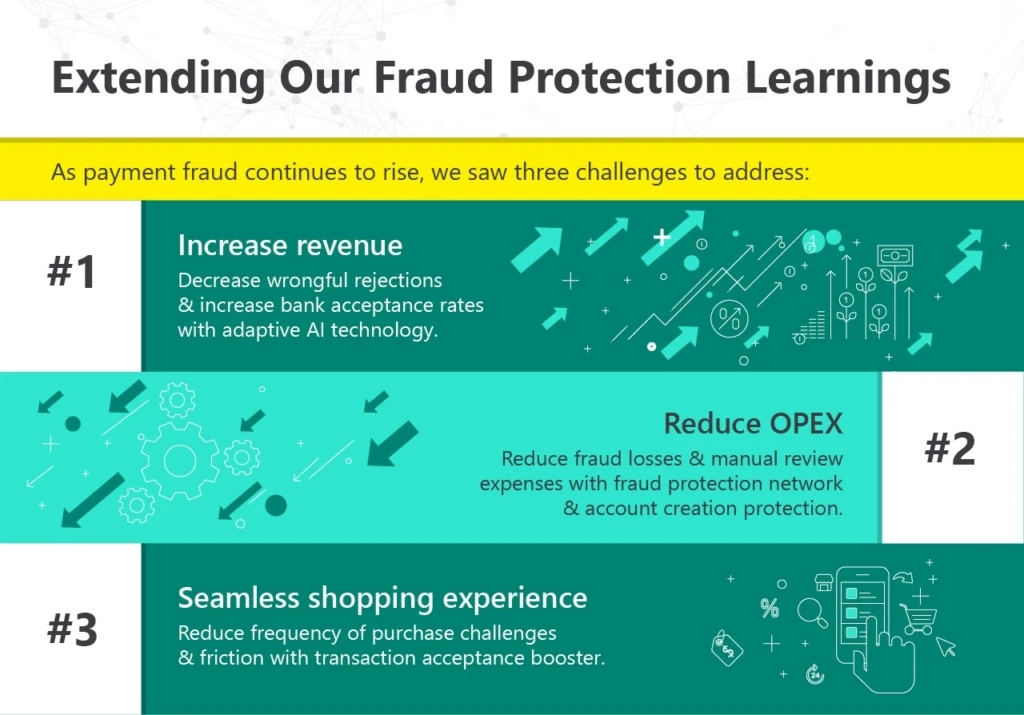
How to fight the three biggest fraud threats in e-commerce purchases
Most of us don’t think twice about making purchases online, whether we’re ordering books and media, grocery deliveries, or big-ticket items like appliances. The increase in digital transactions poses some challenges for e-commerce organizations, especially around fraud.
There are three ways e-commerce organizations are impacted by fraud:
- Lost revenue, when an illegitimate purchase is made on their platform using a hacked account, stolen credit card, or by other fraudulent means.
- Customer satisfaction issues and lost revenue, when a legitimate customer purchase is wrongfully marked as fraud.
- Increased operational expense, to detect fraud and manage chargebacks.
To get a better understanding of this product journey, we sat down with the innovator of the solution, Jay Nanduri, General Manager of Dynamics 365 Fraud Protection Engineering Group. Jay gave us a bit of a history lesson and behind-the-scenes look into how this service was built over time.
You can watch the full video of the interview below.
Microsoft’s fraud protection journey
Jay’s involvement in fraud protection with Microsoft began as the company was going through its own e-commerce transformation, as more Microsoft products and services were purchased by customers across a range of online portals.
According to Jay, Microsoft started its fraud protection efforts with a rule-based system. The early system essentially checked whether a transaction was coming from a rational geo-location, then would approve or deny the transaction.
As Microsoft’s e-commerce business grew, so did the need to make the system more accurate, efficient, and scalable across the different lines of business.
To begin building this new system, the engineering team first had to change its perspective and began looking at the customer journey to understand the weak points in the data sets. The team traced the actions a potential buyer takes that leads to making a purchase and looked at indicators of fraudulent activities that could be flagged as anomalies.
With this knowledge, the team unleashed machine learning (ML) capabilities to more intelligently predict fraudulent transactions and more accurately approve or deny them. Yet, six percent of transactions were still triggering manual reviews. So, the team applied artificial intelligence (AI) and machine learning assets to generate deep learning models to reduce manual reviews and increase the efficiency in catching fraudulent transactions.
Still, when Microsoft approved a flagged transaction and sent it to banks for processing, some payments were rejected, a result of bank systems lacking Microsoft’s trust, knowledge, and signals. To address this, the engineering team created a KPI called profit efficiency, an equation where the maximum profit for a product sale is in the denominator and the actual profit is the numerator.
At this point, the engineering team realized that years of experience detecting fraud on billions of annual transactions could be applied to improving Microsoft enterprise customers’ own processing systems. By delivering fraud protection models as a Dynamics 365 offering built on Azure, customers can take advantage of the innovations built by Microsoft for its own fraud protection efforts. This has culminated in the creation of Dynamics 365 Fraud Protection.
With the creation of the fraud protection network, Microsoft brings merchants’ de-identified data into a consortium that helps algorithms learn more about fraud patterns and become increasingly accurate in detecting fraudulent transactions.
Extending our fraud protection learnings
As payment fraud continues to rise, especially in the online card-not-present channel where liability is with the merchant, so does the increasing costs incurred by companies to combat it. Direct losses and loss related costs to merchants are estimated to reach billions of dollars over the next several years. We saw that our customers were suffering from these costs. We wanted to provide a better way to help customers reduce fraud losses and the associated costs, while increasing revenue and protecting customers and providing an exceptional shopping experience.

From the perspective of both Microsoft and customers, the engineering team recognized three challenges to address with a fraud protection solution.
- Help increase merchants’ revenue by decreasing wrongful rejections and increasing bank acceptance rates.
Dynamics 365 Fraud Protection addresses this challenge by employing adaptive AI technology. Adaptive AI technology continuously learns and adapts from patterns while equipping fraud managers with tools to optimize fraud controls.
- Help reduce operational expenses by reducing fraud losses and manual review expenses.
To do this, Dynamics 365 Fraud Protection utilizes Microsoft’s fraud protection network and account creation protection. The fraud protection network leverages connected knowledge to provide broad awareness of fraud activity across the globe, while keeping the security of organizations’ confidential information and shoppers’ privacy top of mind. Account creation protection helps avoid incurring losses due to fraudulent accounts by monitoring account creation and minimizing abuse and automated attacks on customer accounts.
- Help ensure a seamless shopping experience by reducing the frequency of purchasing challenges as well as friction.
This objective is made possible by Microsoft’s transaction acceptance booster, which shares transactional trust knowledge with issuing banks to boost authorization rates, together with the customer escalation support tool that provides detailed risk insights about each transaction to help improve the customer support experience.
“All this innovation can be given to our customers on Azure as an offering and that’s exactly what became Dynamics 365 Fraud Protection. Why it is a compelling product is because it came from Microsoft’s own experience of processing billions of transactions every year.” – Jay Nunduri, General Manager, Microsoft Dynamics 365 Fraud Protection
Next steps
This blog has been the first in a series where we’ll dive deeper into fraud protection from a high-level standpoint, technical standpoint, and with updates to Dynamics 365 Fraud Protection. I hope this has helped you gain a better understanding of how we approach fraud protection here at Microsoft, and our thinking around the creation of Dynamics 365 Fraud Protection.
To learn more about fraud and how to protect your e-commerce organization, keep following along in this series!




